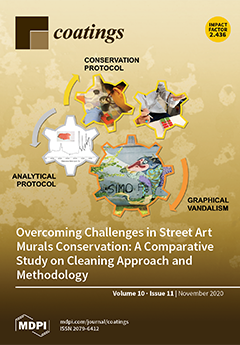Silica-based bioactive glasses (SBG) hold great promise as bio-functional coatings of metallic endo-osseous implants, due to their osteoproductive potential, and, in the case of designed formulations, suitable mechanical properties and antibacterial efficacy. In the framework of this study, the FastOs
®BG alkali-free
[...] Read more.
Silica-based bioactive glasses (SBG) hold great promise as bio-functional coatings of metallic endo-osseous implants, due to their osteoproductive potential, and, in the case of designed formulations, suitable mechanical properties and antibacterial efficacy. In the framework of this study, the FastOs
®BG alkali-free SBG system (mol%: SiO
2—38.49, CaO—36.07, P
2O
5—5.61, MgO—19.24, CaF
2—0.59), with CuO (2 mol%) and Ga
2O
3 (3 mol%) antimicrobial agents, partially substituting in the parent system CaO and MgO, respectively, was used as source material for the fabrication of intentionally silica-enriched implant-type thin coatings (~600 nm) onto titanium (Ti) substrates by radio-frequency magnetron sputtering. The physico-chemical and mechanical characteristics, as well as the in vitro preliminary cytocompatibility and antibacterial performance of an alkali-free silica-rich bio-active glass coating designs was further explored. The films were smooth (R
RMS < 1 nm) and hydrophilic (water contact angle of ~65°). The SBG coatings deposited from alkali-free copper-gallium co-doped FastOs
®BG-derived exhibited improved wear performance, with the coatings eliciting a bonding strength value of ~53 MPa, Lc3 critical load value of ~4.9 N, hardness of ~6.1 GPa and an elastic modulus of ~127 GPa. The Cu and Ga co-doped SBG layers had excellent cytocompatibility, while reducing after 24 h the
Staphylococcus aureus bacterial development with 4 orders of magnitude with respect to the control situations (i.e., nutritive broth and Ti substrate). Thereby, such SBG constructs could pave the road towards high-performance bio-functional coatings with excellent mechanical properties and enhanced biological features (e.g., by coupling cytocompatibility with antimicrobial properties), which are in great demand nowadays.
Full article





